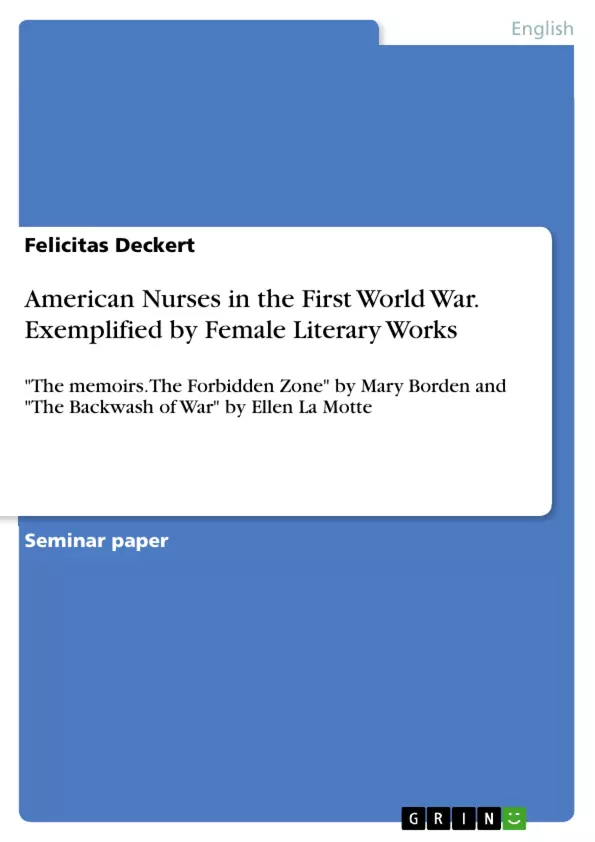This term paper focuses on how American nurses, representing white middle-class women, coped with the trauma nursing in the First World War caused. In addition, it will be discussed how they dealt with societal constraints concerning women in general and women in the nursing profession in particular.
Women have long been neglected as authors about the First World War. Things changed during the last three decades when more and more researchers began to uncover women’s voices. They have argued that women present an important part in the canon of First World War literature. Even though it started as European war, some American women joined the war effort, long before the United States entered the conflict. Mostly these women were employed as nurses in army hospitals along the frontline. For nurses the First World War somehow meant a new sense of freedom, even though they sticked to the domestic world of caretaking.
The study shows how the mud of the western front provided an opportunity to rise from the limited domestic sphere to the battlefield of the modern world. "The memoirs The Forbidden Zone" by Mary Borden and "The Backwash of War" by Ellen La Motte are among the best known female literary works and will serve as examples to show she characteristics of female wartime writing. While women could not directly attest to the experience of the trenches, they were the only ones able to explore war’s all-consuming effects. Therefore, women’s voices like Borden’s and La Motte’s deserve much more attention, as their texts hold a not yet fully discovered truth and richness of accounts of the First World War.
Inhaltsverzeichnis (Table of Contents)
- 1 Introduction
- 2 American Women at War
- 2.1 Nursing the Nation
- 2.2 Nursing and Suffrage
- 2.3 Nursing in War
- 2.4 Aftermath of the Great War
- 3 Approaching Female War Writing
- 3.1 The Memoir as Meaning Maker
- 3.2 Ellen La Motte - The Backwash of War
- 3.3 Mary Borden - The Forbidden Zone
- 4 Conclusion
- 5 Bibliography
Zielsetzung und Themenschwerpunkte (Objectives and Key Themes)
This paper explores how American nurses, primarily white middle-class women, confronted the traumatic experiences of nursing during the First World War. It examines their coping mechanisms and the challenges they faced within the societal constraints placed upon women, particularly in the nursing profession. The paper argues that the harsh realities of the Western Front provided a platform for these women to transcend the limitations of the domestic sphere and enter the battlefield of the modern world. The memoirs "The Forbidden Zone" by Mary Borden and "The Backwash of War" by Ellen La Motte serve as primary examples to highlight the characteristics of female wartime writing.
- The experiences of American nurses during the First World War
- The impact of societal constraints on women in nursing
- The role of female wartime writing in exploring the effects of war
- The significance of the memoirs "The Forbidden Zone" and "The Backwash of War"
- The evolution of nursing as a profession in turn-of-the-century America
Zusammenfassung der Kapitel (Chapter Summaries)
- Chapter 1: Introduction: This chapter sets the context for the paper by highlighting the historical neglect of women's voices in First World War narratives. It emphasizes the crucial role of American nurses in the war effort and introduces the central focus of the paper: examining how these women navigated the challenges and opportunities presented by their wartime experiences.
- Chapter 2: American Women at War: This chapter delves into the various ways in which American women contributed to the war effort both at home and abroad. It explores the shifting gender roles, the challenges faced by women in the workforce, and the evolving perception of women's roles in war. It also touches upon the initial resistance towards women's participation in war work and the contrasting realities faced by nurses in the field.
- Chapter 2.1: Nursing the Nation: This section focuses on the evolution of nursing as a profession in turn-of-the-century America. It highlights the historical context of nursing as a traditionally female role, the establishment of nursing schools, and the influence of figures like Florence Nightingale on shaping the profession. It also explores the interconnectedness between the development of nursing and the broader feminist movements of the late 19th and early 20th centuries.
Schlüsselwörter (Keywords)
This paper explores themes related to American women, nursing, the First World War, female war writing, domesticity, societal constraints, wartime experiences, memoirs, and the evolution of nursing as a profession.
- Citation du texte
- Felicitas Deckert (Auteur), 2020, American Nurses in the First World War. Exemplified by Female Literary Works, Munich, GRIN Verlag, https://www.grin.com/document/1160715



